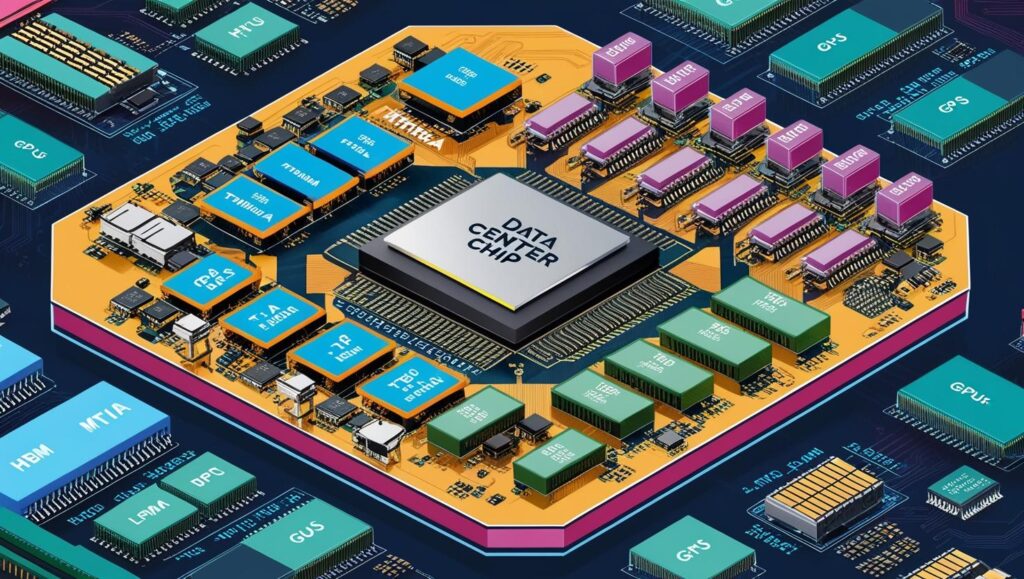As the global demand for artificial intelligence (AI) infrastructure accelerates, investors are increasingly turning their attention to Data Center Chip Innovation as a critical driver of future growth. The surge in AI applications—from generative models like ChatGPT to real-time analytics and edge computing—is placing unprecedented strain on traditional data center architectures. In response, the industry is undergoing a transformation fueled by advanced silicon and custom chip design.
The Role of Data Center Chip Innovation in AI Infrastructure
At the heart of this transformation is Data Center Chip Innovation, which has become essential for enabling high-performance computing, optimizing power efficiency, and scaling AI workloads. Traditional CPU-based infrastructure is no longer sufficient to handle the exponential growth in data and compute requirements. In its place, investors are betting on GPU acceleration, AI-specific chips (ASICs), and custom silicon developed by hyperscalers like Amazon, Google, and Microsoft.
Leading chipmakers—including NVIDIA, AMD, and Intel—are doubling down on Data Center Chip Innovation, introducing AI-optimized architectures and integrating cutting-edge technologies such as chiplets, 3D stacking, and advanced cooling systems. Meanwhile, startups like Cerebras, Graphcore, and SambaNova are attracting venture capital by offering alternative solutions that challenge the incumbents.
Market Momentum and Investment Trends
Recent forecasts project that the global The global data center chip industry is expected to grow from USD 206.96 billion in 2025 to USD 390.65 billion by 2030, growing at a CAGR of 13.5% from 2025 to 2030. Venture capital and institutional investors are rapidly funneling capital into this space, citing its critical role in enabling AI and cloud scalability.
Download PDF Brochure @ https://www.marketsandmarkets.com/pdfdownloadNew.asp?id=39999570

Private equity is also entering the fray, with firms acquiring or funding fabless semiconductor startups focused exclusively on Data Center Chip Innovation. These investments are not just in hardware, but also in the software and tooling ecosystems that support chip development, including EDA tools and AI compiler optimization layers.
Why Investors Are Paying Attention
There are several compelling reasons why Data Center Chip Innovation is attracting investor interest:
- Massive AI Workloads: AI training models like GPT-4 and beyond require trillions of parameters and massive parallel processing, only possible with advanced chips.
- Cloud Scalability: Cloud service providers are optimizing for performance-per-watt and latency, which is only achievable through silicon-level improvements.
- Geopolitical Importance: Chips have become central to national security and economic competitiveness, adding a strategic layer to investments in Data Center Chip Innovation.
- In-House Silicon: Hyperscalers are building custom chips, reducing reliance on third-party vendors and signaling a long-term commitment to hardware innovation.
Risks and Opportunities
While the opportunities are significant, Data Center Chip Innovation comes with inherent risks. High R&D costs, supply chain constraints, and increasing regulatory scrutiny—especially around exports to certain regions—can affect growth trajectories.
Still, the opportunity outweighs the risks for many investors. As AI applications continue to expand into healthcare, finance, defense, and consumer tech, the chips that power those systems will be mission-critical. Companies leading in Data Center Chip Innovation are likely to become central to the digital economy.
Over the past 3 to 5 years, Japan has seen a significant rise in the number of cloud providers entering the data center market. As a global leader in the adoption of advanced communications technologies, Japan was among the first countries to experience a substantial increase in data center interconnect (DCI) bandwidth demand. This robust DCI infrastructure has supported rapid advancements in 5G deployment and edge computing adoption across the country.
For example, in February 2022, GLP unveiled plans for a 900 MW data center expansion in Japan, signaling strong market momentum. Such developments present a major opportunity for modular data center vendors to supply reliable and efficient components that ensure operational continuity.
The market has further evolved with the entry of international hyperscale cloud providers. Leading firms such as Amazon Web Services (AWS), Google, Microsoft Azure, SoftLayer, and IBM have been expanding their footprint in key hubs like Tokyo and Osaka. As these hyperscalers drive demand for IoT services and edge computing infrastructure, the need for scalable, modular data center solutions is expected to grow significantly.
The Future Data Center Chip Outlook
The coming years will be defined by a race for silicon superiority. Companies that innovate faster and more efficiently in the data center space will win not just customers, but market dominance. For investors, Data Center Chip Innovation represents not only a high-growth sector but a foundational technology for the next decade of computing.
AQ: Betting Big on Data Center Chip Innovation Amid the AI Boom
Q1: Why is Data Center Chip Innovation critical for the AI boom?
A: AI workloads require massive computing power and efficiency. Traditional chips can’t keep up with the scale and speed AI demands. Data Center Chip Innovation drives performance gains, power efficiency, and scalability essential for AI’s growth.
Q2: What makes Data Center Chip Innovation an attractive investment opportunity?
A: The rapid expansion of AI applications and cloud infrastructure is fueling unprecedented demand for next-gen chips. Companies leading in chip innovation have strong growth potential, making this sector highly promising for investors.
Q3: Which companies or sectors are leading in Data Center Chip Innovation?
A: Major players include NVIDIA, AMD, Intel, and emerging startups like Cerebras and Graphcore. Additionally, hyperscalers like Amazon and Google are investing heavily in custom silicon, signaling market shifts.
Q4: What are the main risks investors should be aware of?
A: Risks include high R&D costs, supply chain challenges, geopolitical tensions affecting chip manufacturing, and intense competition. Regulatory changes and rapid tech shifts also require careful monitoring.
Q5: How does Data Center Chip Innovation impact long-term market trends?
A: It’s reshaping the entire computing landscape by enabling AI, edge computing, and cloud scalability. Firms that innovate faster will dominate market share and influence future tech ecosystems.